Husky training and education at home
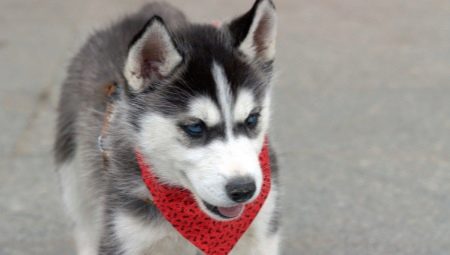
Husky is a breed of sled dogs native to the northern regions. They were bred by the Chukchi and were originally used as a power traction for transporting goods and people on sledges. Mushers regulated the number of dogs in a team depending on the load. These are wayward and very beautiful animals that obey a person if he is stronger. This also happens in a pack, where weaker individuals recognize the authority of the leader - the leader of the pack.
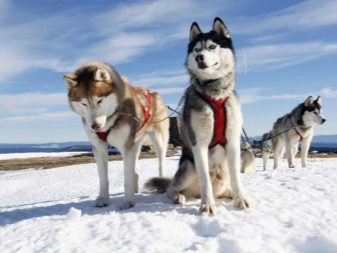
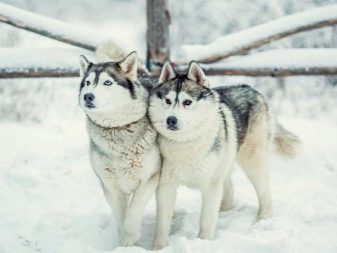
Character and behavior
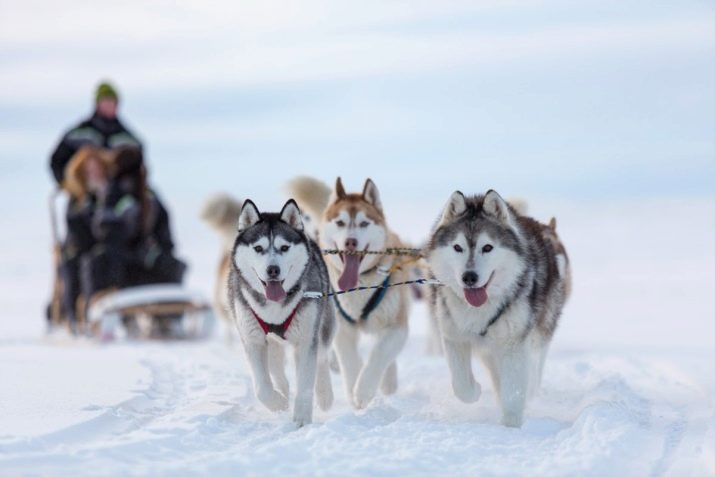
A small husky, despite its beautiful coat color and expressive blue or brown eyes, can show itself from a rather unexpected side: this is not a playful, affectionate and obedient doggie, but a very smart, quick-witted and cunning dog with a tough disposition. Therefore, from the first months of life, the pet must firmly know what discipline is. And much depends on the very nature of the owner.If this is a person with a good-natured character, melancholic, absent-minded, slow, then the husky will immediately begin to "dictate" its terms.
On the other hand, people with a quick-tempered and harsh character, who are accustomed to solving issues by the method of psychological pressure, loud shouts and, even worse, with the help of physical violence, will also not succeed in training this breed. At best, the dog will become sullen, uncommunicative, at worst, it can seriously bite the offender. This breed appreciates a fair attitude towards itself: commands are given to the dog in a calm and strict tone - it fulfills them, receiving tasty "encouragement" for this.
Therefore, when training this breed, one should not go to extremes - huskies study the character of the owner, and if they do not recognize his authority, then it is extremely difficult to achieve submission from her.
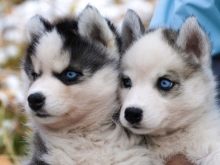
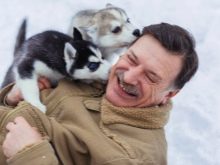
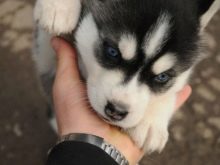
From two months of life, the puppy must be accustomed to the place, fed at a certain time, be sure to walk with him. Open space is the lifeblood of a dog. Tired after an active walk, she fulfills commands much better, is less distracted, and thinks faster.
There must be a clear balance between strict and affectionate attitude - Husky needs both. From a puppy that no one cares about, a dog grows up that does not obey anyone in the house - it breaks off the leash, gnaws people's things in the house and leaves to wander when the owner is barely distracted from him for a walk. The prospect is unpleasant, therefore Before starting a pet, you should carefully weigh the pros and cons.
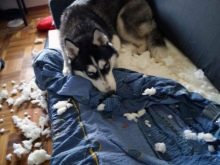
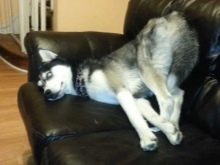
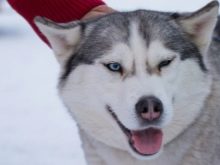
How to choose a puppy?
Close attention is paid not only to the appearance of the puppy, but also to his behavior. Health and good physical condition can be determined by the following signs:
- the ears are dense, the tips stick up, the pet reacts well to any sounds;
- straight teeth, normal bite;
- tail does not lift up above the back, down;
- strong build;
- lively reaction to external stimuli: curiosity, attentiveness, energy;
- smooth, shiny, silky coat (color may vary).
It is necessary to determine exactly for what purposes a dog is required: for riding in a sled, it is better to purchase a puppy from experienced breeders, for home keeping, you can buy a husky with a good pedigree from amateurs. Therefore, the price of puppies will be different - from 30 to 60 thousand rubles.
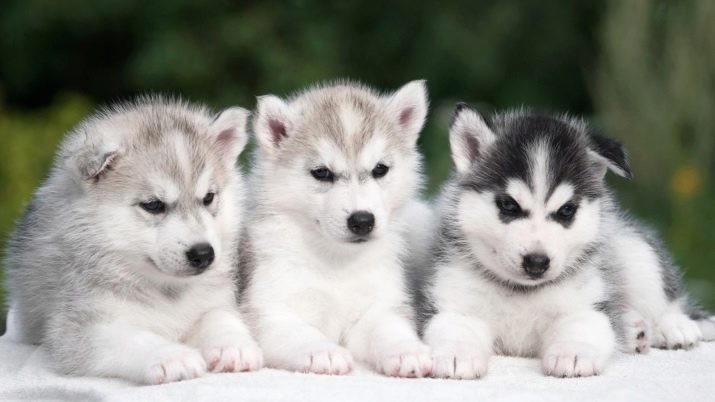
The subtleties of education
The harsh climate of the Far North does not indulge either people or animals. The law is immutable there: the fittest survives. Pack life provides this breed of dog with a certain degree of safety.
The leader in the group is the leader. He makes independent decisions, chooses the path, avoids dangerous places, and the rest of the dogs follow him... Huskies live in an environment where mushers change, but the backbone of the pack remains the same. Therefore, the dogs first of all obey the leader of the pack, and then the man. The character trait that huskies have acquired in such harsh conditions is independence. This fact must be taken into account when training a pet.
Another important point is the desire to imitate. Dogs in a pack are a "clan" where their close contact takes place. Younger huskies quickly adopt the experience of their older brethren. In conditions of low subzero temperatures, often poor and monotonous nutrition, new habits will save their lives more than once. Moreover, the "rules of the game" will be learned only when the unconditional authority of stronger individuals is recognized.

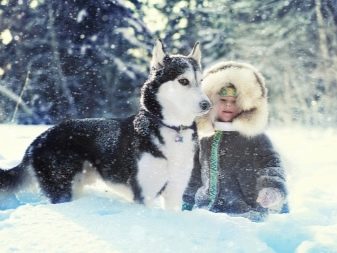
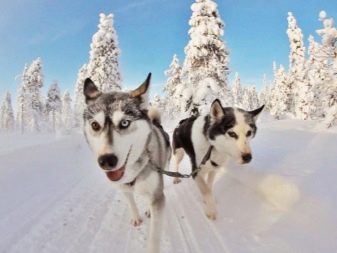
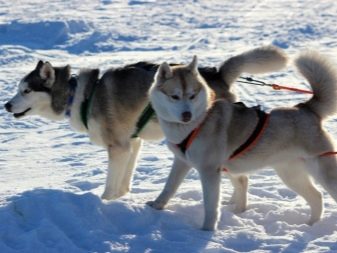
Other distinctive features of the husky character:
- striving to take a leading position;
- stubbornness, the desire to get out of the control of the owner;
- quick-wittedness, sharpness - dogs quickly "grasp" what they want from them;
- high intelligence;
- developed hunter instinct;
- the desire for independent walks.
If people, due to circumstances, cannot devote 3-4 hours a day to a pet for training and education, it makes no sense to have a husky - the dog will do what it wants, and as a result, it may disappear in an unknown direction during a walk. But before that, she will ruin the valuables in the house (if she is not accustomed to only deal with her toys), intimidate other pets (tendency to dominate) and, possibly, bite the child.
Children do not understand how much the husky values his independence, they try to play with him, and in the absence of discipline, a human cub for a pet is an annoying hindrance. To raise a husky on your own, you need to be clearly aware of the degree of responsibility that will fall on the shoulders of the owner.

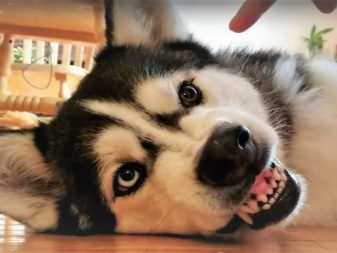
At what age can you train?
Husky can learn basic commands as early as 2 months. At this time, there is a close emotional contact with household members. The pet gets used to family members, distinguishes them from guests and strangers.
The puppy will not show aggression towards other animals in the house if he constantly sees them from a young age. But this is possible with the right upbringing. It's too early to talk about training - it starts at 4-5 months. But such commands as "No", "Place", "Come to me" Husky will learn quickly. The leader for her in the family is not necessarily a breadwinner, but a person with dominant character traits.
Regardless of whether the husky boy or girl has to be raised, this breed does not like to obey. It may seem to the owners that the dog does not hear them, although in fact the puppy only pretends as if he does not understand what they want from him.
Husky boys are more friendly and malleable in this sense, and girls are wayward, independent stubborn, with whom you will have to tinker with. The sooner you begin to teach the puppy to commands, the more obedient and diligent he will be in adulthood.


Basic rules of training
To be successful in training, you need to learn a few rules:
- commands are pronounced clearly, in a low and confident voice - there should not be shrill and high intonations in it;
- the dog perfectly assimilates information through the method of encouragement and punishment, but the "whip" in this case is the deprivation of delicacies or the formation of a feeling of resentment by pressing the puppy to the ground (in no case shouting or assault);
- huskies are much better trained in a group of other dogs;
- before teaching the dog commands at home, you must definitely consult with an experienced dog handler or sign up for an OKD (general training course).
The advice of a specialist will help you feel more confident in raising a wayward pet. A correctly formed training scheme is a guarantee that the commands will be learned quickly, and the husky will not have to be retrained at an older age if there were any flaws in the training. For any correctly performed action, the dog receives a tidbit, favorite toy or affection from the owner.
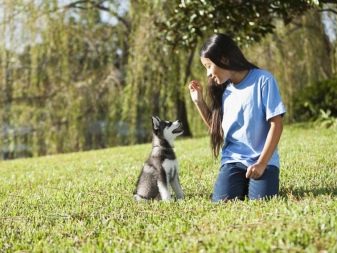
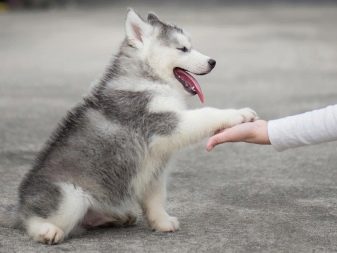
Basic commands
Learning to complete basic tasks occurs gradually throughout the day. It is a mistake to believe that 1-2 hours of continuous training will ensure success. It will be better if the teams are given from time to time during the day.
- "A place"... The puppy tries to lie down where it is softer, more comfortable, warmer: on a sofa, an armchair, a carpet. The owner determines the place for rest as soon as the dog was brought into the house. When the husky begins to pack where she wants, you need to take her to the "couch" and give the command "Place". The puppy can be rewarded with a piece of treat.
- "It is forbidden"... You need to make sure that the pet has its own toys. When his teeth are teething, everything that is bad is used: boots, slippers, gloves, bags. Showing aggression towards other pets or children requires an immediate response. Therefore, the command "Fu" or "No" must be learned immediately.The husky's unwanted action is stopped instantly: a prohibited object is pulled out of the mouth, the puppy is pressed to the floor or ground. If he wanted to bite someone, the mouth is clamped with a hand. At this time, a command is pronounced, which should sound loud, confident, stern.
- "Nearby". Team training takes place on the street. First, huskies are taught to use a soft collar by putting it on for a few minutes before walking. She will quickly get used to it, because this action will be associated with the emotion of joy. A strong leash clings to the collar. The dog will seek to escape from the owner on the street. She is pulled to her left leg with a light jerk and sternly commanded: "Near." It is important that the puppy does not run forward, backward, or to the sides, but walk near the leg.
- "Sit". A treat for a dog is placed at the level of its nose so that it does not lift its head up, but can observe the owner's movements from a sitting position. You can put a little pressure on the withers until the dog sits down, say: "Sit" and reward your little friend with a tasty treat.
- "Lie". The assimilation of the command occurs after the flawless execution of the previous one. When the dog is sitting, the croup is pressed, and the treat is lowered even lower to the floor. When the pet fulfills the command, it is given a treat.
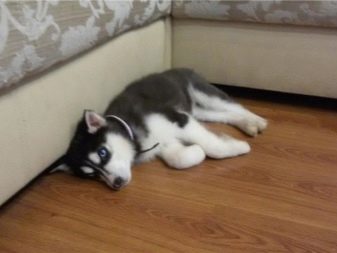
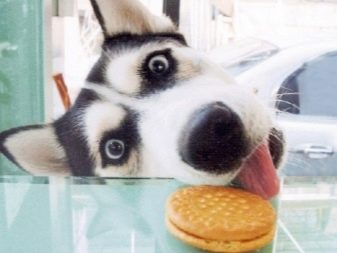
What not to do
The pet must be confident in himself and in his "leader", that is, in the owner. With the wrong upbringing, the husky does not become cowardly - it will be sullen and aggressive. In this case, all objects moving in its direction act as a threat to it. In order not to spoil the character of the pet, you need to firmly learn what cannot be done:
- shout;
- use cooing intonations in the voice;
- ignore daily walks;
- live in disorder, when a lot of things are out of place;
- take the puppy out into the street, pressing him with his back to the chest (the belly is open, which means that the vital organs of the husky are not protected from potential threats);
- squeeze the dog like a plush toy;
- feed monotonously and poorly;
- forgetting your pet at home for a few days.
If a cat or a hamster can be alone for several days, then this story is not about a husky. It was decided to buy a puppy - he should be treated like a full-fledged member of the family, and not like a beautiful toy. Severity, discipline, love - these are the main criteria without which the life of a husky and his owner will turn into torment.
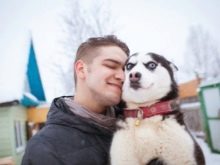
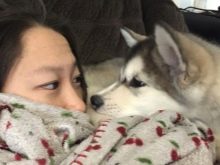
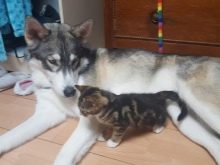
Rewards and punishments
The dog's favorite treats are used to reward the dog for doing the right thing. This can be cheese, jerky meat, dry food (undesirable). Here, the approach must be individual. The main thing is the positive motivation of the animal.
Both reward and punishment must be followed immediately. You cannot punish a husky when she did something reprehensible a few hours ago - this can only be done in hot pursuit. Before you let your pet know that he made a mistake, you need to carefully analyze what caused his action.
- Gnawed at the walls and wallpaper. Pay attention to the diet - it is possible that the dog's diet lacks certain minerals and vitamins.
- He ripped the curtains, ruined furniture, bit a shoe. Buy a puppy toys, do not leave him at home for a long time. The kid is bored alone - he entertained himself as best he could. He had no idea how important the safety of interior items was for the owner.
- Chased another pet. Husky has a hunting instinct. Either a new resident appeared in the house recently and the puppy is not yet used to him, or he himself is humiliated by people.
- Bitten a child. The puppy has become aggressive due to improper upbringing. He became a hindrance to people, they don't like him.
- Goes to the toilet at home whenever he wants. They don't walk with huskies or take them out for a walk when they can. Not tray or diaper accustomed. Perhaps, no one has dealt with this problem at all.
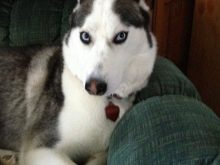
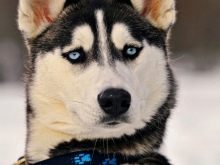
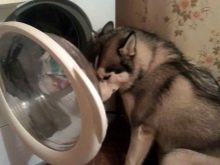
Huskies do not tolerate humiliation, physical abuse, negligence, bad habits of people.No wonder they say that the pet adopts the character traits of its owners. An embittered, distraught, unhappy person will grow up a wild, aggressive, terrible dog that will pose a threat not only to himself, but also to those around him.
And with proper, adequate upbringing, when the owner feels happy and is ready to share a piece of happiness with a cheerful, agile, mischievous pet, positive returns will follow immediately.
The puppy should have a rich, nutritious diet. They feed, as well as walk, with him at the same time. It is necessary to encourage and punish the pet immediately, then he will quickly catch the connection between cause and effect. It is advisable to constantly expand the horizons of the eared friend, visiting new and new places with him.
You can not prevent him from communicating with other dogs on the street. He develops a friendly, loyal attitude towards other animals. But it is necessary to ensure that further communication with other people's pets does not lead to unpleasant moments (he went for a walk with the "bad company", reacted aggressively to the defiant behavior of another dog). The average life span of a husky is 12-15 years. And all this time the owner must be a parent, friend and undisputed leader of the "pack" for him.
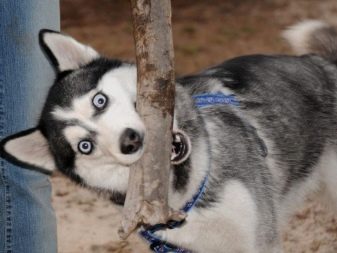
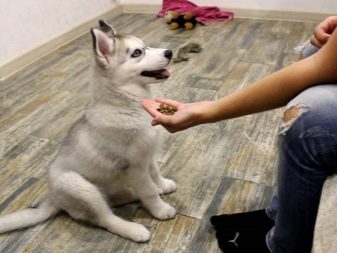

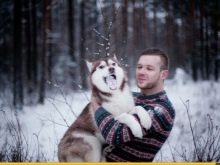
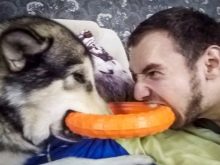
The features of training dogs of this breed are described in the video below.






































